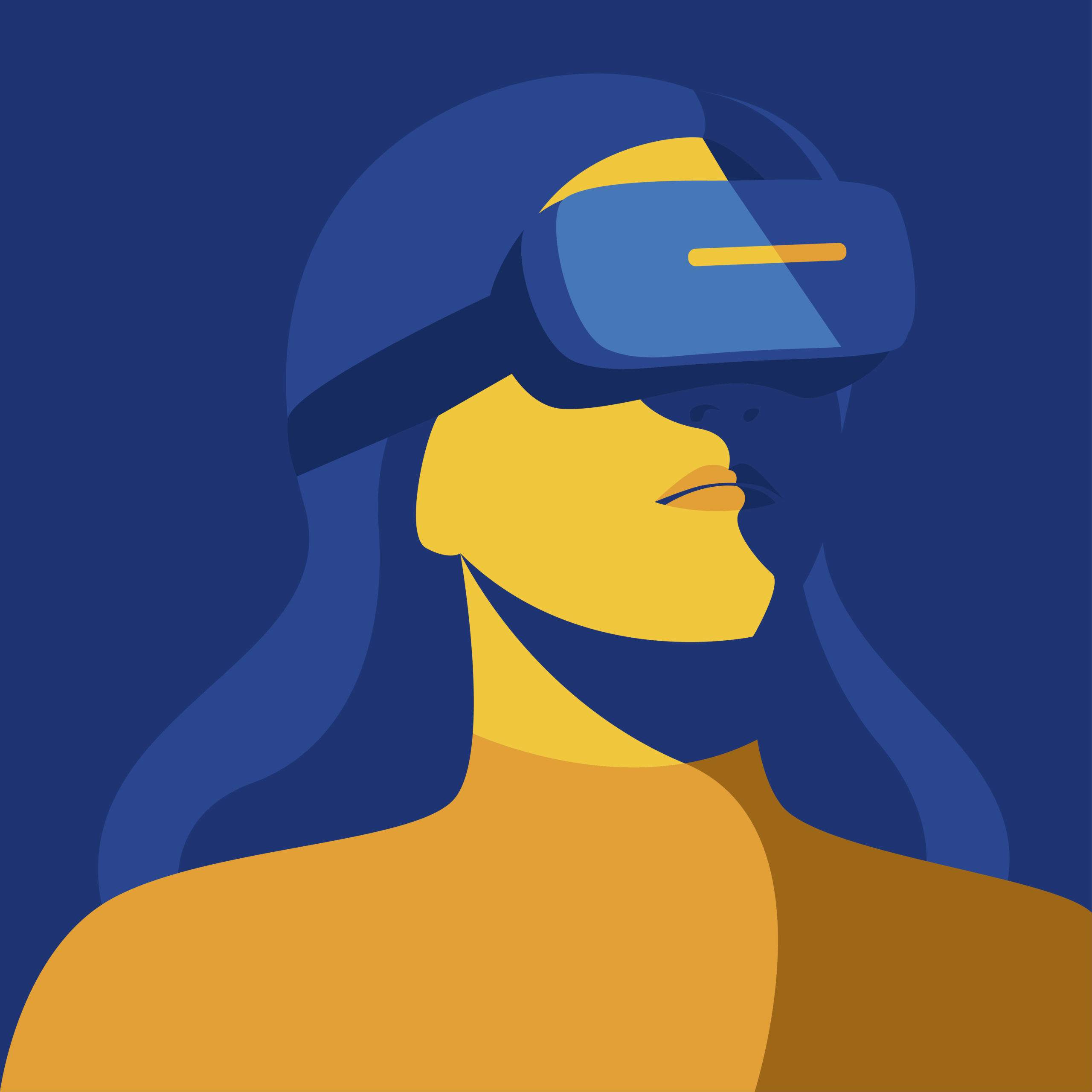The empathy machine?
Virtual reality and the search for a solution to violence
Featured in

AS A COMMITTED reader whose idea of leisure time involves a book, a comfortable seated position and a glass of wine, I rarely take notice of tech developments, especially in entertainment and gaming. Anything requiring a headset, in particular, elicits only disinterest and a sense of Gen-X incompetence. In short, I’m an unlikely candidate to write about virtual reality (VR), but my interest in the technology was piqued when I came across an article in Scientific Reports in February 2018 relating the findings of a team of researchers from the University of Barcelona who used VR to put perpetrators of domestic violence in the shoes of their victims.
For this study, participants – twenty male domestic violence offenders and a control group of nineteen with no history of violent offending – were fitted with a head-mounted display (HMD) that immersed them in a virtual scene in which they embodied a female avatar. After viewing themselves in a virtual mirror, they touched a series of coloured balls to further establish bodily identification and movement synchronicity. An aggressive man then entered via a virtual hallway and began verbally abusing them. As the abuse escalates, the man strikes a mobile phone off a table in the direction of the participant. He then closes in on the participant until he is yelling in ‘her’ face. If the participant tried to interrupt, the controller could make the man say ‘Shut up!’, or demand ‘she’ look at him if the participant turned away.
By assessing participants’ ability to recognise emotion beforehand, the researchers found that the offender group had ‘significantly lower ability to recognise fear in female faces’ compared with the control group. After their virtual embodiment as the female victim, however, offenders’ ability to recognise fear in female faces improved. Given the ability to accurately recognise emotions ‘is a key component of empathetic responses’, the researchers concluded that immersive VR could induce ‘positive changes in actual offenders’. As caveats, however, they admit more research that investigates ‘subjective, physiological and explicit changes’ is needed and that ‘the final objective should be to search for behavioural changes that contribute to reducing future reoffences’. The ability, in other words, to recognise fear in a woman’s face alone may not be enough to affect the sort of real behavioural change needed to solve the problem of gendered violence.
Statistics on domestic and gendered violence in Australia barely need reiterating: on average, one woman a week is murdered by her current or former partner. Many agree the situation constitutes a national emergency. So while it’s unrealistic to expect a legitimate research study to produce anything other than modest results with relevant cautions and stipulations attached, the possibilities of VR to make perpetrators feel real empathy for their victims, and in way that might affect long-term behavioural change, are tantalising.
A CURSORY GOOGLE search soon reveals that ‘VR as the ultimate empathy machine’ – as VR filmmaker and proselytiser Chris Milk calls his 2015 TED talk – is not just a niche academic research interest, it’s a movement. And like all movements, it has its prophets and zealots. According to Milk in a 2016 TechCrunch interview, VR promises the ‘democratisation of human experience’. Milk talks with TED-characteristic zealous-but-measured certitude about the potential of VR to change hearts and minds through its ability to connect ‘humans to other humans in ways we’ve never seen before’. Along with Aaron Koblin, Milk co-founded the VR production company Within (formally VRSE), which describes itself as ‘the premier destination for innovative, entertaining and informative story-based virtual and augmented reality’. His first VR documentary, made in collaboration with creative director Gabo Arora, was Clouds over Sidra in 2015, a ‘canonical’ VR empathy piece according to Jeremy Baileson, the head of Stanford University’s Virtual Human Interaction Lab. Made in collaboration with the United Nations to draw attention to the Syrian refugee crisis, Clouds over Sidra is proof, Milk claims, that VR ‘has the potential to change the world’. The eight-minute film depicts the daily life of Sidra, a twelve-year-old girl living in the Za’atari refugee camp in Jordan, from her family’s living quarters in a makeshift tent to her school and the gravel pitch where she plays soccer with other children. When it screened at a meeting for ‘high-level donors’ prior to the Third International Humanitarian Appeal for Syria in Kuwait in 2015, it raised US$3.8 billion – 70 per cent above the projected amount.
Nonny de la Peña, a journalist and VR innovator, is another evangelist for the medium who believes traditional media does not come close to the powers of VR to create stories ‘you remember with your entire body and not just your mind’, as she puts it in a 2015 TED talk, where she speaks with the fervour of a true believer. De la Peña heads Emblematic Group, which, in collaboration with news organisations and platforms such as The New York Times, Associated Press, Al Jazeera and Google, has created a suite of VR scenarios reconstructed from real news stories or incidents. As a journalist who has worked in print, documentary and broadcast, it wasn’t until she ‘got involved in virtual reality that [she] started seeing these really intense, authentic reactions from people that really blew [her] mind’. In her TED talk, de la Peña, widely known as the ‘godmother of VR’, describes it as a ‘visceral empathy generator. It can make people feel in a way that nothing, no other platform I’ve ever worked in, can successfully do in this way.’
Emblematic’s first foray into ‘immersive journalism’ was Hunger in LA (2012), a VR vignette about a diabetic who collapsed while waiting in a food-bank queue in Los Angeles. When the piece debuted at the 2012 Sundance Film Festival, de la Peña says people wearing HDM were getting ‘down on the ground to try to comfort the seizure victim’. Their next immersive piece was, like Clouds over Sidra, about child refugees from Syria. Commissioned by the head of the World Economic Forum after he viewed Hunger in LA, 2014’s Project Syria featured material recorded in refugee camps on the Syrian–Iraq border. The piece begins with a young girl singing in a re-created street scene in which a bomb then goes off. The viewer is among the chaos, hearing the explosion, seeing the injured. ‘It’s an incredibly scary and real feeling’, says de la Peña, adding that real survivors of bomb attacks assure her the VR simulation evokes the same kind of fear.
De la Peña stresses that all their VR stories adhere to ‘the basic tenets of journalism’ and follow ‘the same principles’. The only difference with this new form of journalism, she states, is that the viewer, or participant, has a sense of ‘being on the scene’. Since de la Peña’s TED talk, Emblematic have collaborated with various organisations to produce VR stories on social issues such as domestic violence and lax gun control in the US (Kiya), safe access to abortion services (Across the Line), family hostility and homelessness within the LGBTQ community (Out of Exile), and climate change in a piece called Greenland Melting. But who’s watching them? How accessible are they? And are they reaching the people whose hearts and minds they wish to change? The answers are not easy to ascertain.
To assess the effectiveness of VR as empathy tool for myself, I picked up a $10 pair of VR goggles from Kmart and watched Emblematic’s DV story Kiya (2015) on YouTube – the only one of Emblematic’s VR stories on the platform. The other cheap option for viewing VR pieces is Google Cardboard – literally a cardboard kit with VR lenses that folds into a box into which you place a smartphone. Quality wise, the Kmart goggles are no top-of-the-range Oculus Rift, but they still do the trick of putting you ‘in the middle of the story’, as de la Peña puts it. As one of Emblematic’s earliest pieces, the animation lets Kiya down – it just doesn’t look ‘believable’. Kiya is based on an incident that happened in South Carolina in which two sisters tried to intervene to prevent a third sister, Kiya, being shot by her former boyfriend. According to Emblematic’s website, the piece was reconstructed from location and crime-scene photos, interviews with the survivors, 911 calls from the sisters, and police and court records. Unlike the Barcelona domestic violence scenario, you as the viewer do not embody an avatar in the scene – you are simply a (helpless) bystander to the drama. And though you do not witness the actual shooting – you, along with the two sisters, are outside the house by this stage – the experience, I found, was uncomfortably voyeuristic. There’s also the problem of motion sickness, which VR-hardware creators haven’t yet solved. The only thing I felt an emotional response to – anger and horror, primarily – was the text that appears on screen at the end stating, ‘On average, three women a day are killed by their husbands or intimate partners in the United States.’
As to the net effect of turning harrowing pieces of journalism into VR scenarios – that is, what they specifically want to achieve – de la Peña doesn’t elaborate much. Empathy, yes – but empathy to what end? ‘These things have made an impact,’ de la Peña says. ‘I’ve had Americans tell me that they’ve donated, direct donations from their bank account, money to go to Syrian children refugees,’ is her summative TED statement. If the goal is to stimulate empathy in order to elicit donations, rather than long-term behavioural change, it would seem that empathy VR, at least in this context, is little more than a marketing tool. The United Nations Virtual Reality website does little to disguise the fact that its four issue-based VR films to date – all made in collaboration with Within and other stakeholders – are key to their fundraising efforts. VR has the potential to make comfortable Westerners throw money at global humanitarian crises – but what else?
The most affecting piece I watched on Within’s VR app (also available on YouTube) was The Displaced, an eleven-minute documentary made in collaboration with The New York Times about the lives of three children (of thirty million) who have been displaced by global conflict and war. The incongruence of feeling floorboards beneath my feet while my eyes told me I was standing in a grass field was disconcerting, and when I walked into the pedestal fan in the corner of my room, I thought I’d bumped into someone picking up a sack of grain in the simulation I was immersed in. The most powerful moments in the piece were when children broke the fourth wall to make eye contact, especially when I looked down to see them smiling at me. Objectively, I knew they were looking at the multidirectional camera, but that moment of connection felt very close to being real, and it was then that I thought: maybe there is some value in this experience. The cynical part of me, however, is aware that this ‘value’ must then be quantified or converted into donation dollars for it to mean anything.
FOR EVERY TED talk, interview with Chris Milk and think piece spruiking the empathy powers of VR on the internet, there are a growing number of articles questioning, challenging and outright criticising claims about the efficaciousness VR as an empathy generator. Though there’s a certain contrariness to these articles, they do raise considered and valid arguments. For example, Paul Bloom, a Yale psychology professor, writing in The Atlantic in February 2017, argues that ‘[t]he awfulness of the refugee experience isn’t about the sights and sounds of a refugee camp; it has more to do with the fear and anxiety of having to escape your country and relocate yourself in a strange land’. Story, he’s saying, is essential to effective/affective VR empathy pieces, not merely short-term sensory immersion in the experience of another.
Looking at Stanford University’s Virtual Human Interaction Lab’s (VHIL) most recent VR empathy research projects – and how their trials have evolved in the past fifteen years – it’s clear that narrative or story is becoming a more integral part of VR-empathy research. VHIL’s last VR-empathy project Becoming Homeless took (some) participants on a VR narrative-based journey through eviction and homelessness, and the challenge of living with increasingly fewer resources. The results of the trial, published in October 2018, are the most promising so far in suggesting that empathic attitudes induced through a VR scenario can endure over time. VHIL’s current research project, 1000 Cut Journey, is described as ‘an immersive reality experience that allows you to walk in the shoes of Michael Sterling, a black male, and encounter racism firsthand as a young child, an adolescent and a young adult’. Another VHIL research project, ‘Empathy at Scale’, has been designed to study the effects of empathy-VR long term by following a broad-ranging and demographically diverse group of people over time, thus overcoming the limitations of earlier studies in ascertaining the effectiveness of empathy-VR.
As prudent as the results may be, the real measures of VR’s ability to create empathy for the greater good, with long-lasting effects, will ultimately be legitimised by scientific quantitative studies and scholarly, peer-reviewed research. It’s anyone’s prediction, however, as to when VR empathy technology will move from the lab into the sort of targeted real-world settings that would most benefit from them. On that note, I was curious to know if VR would be something a practitioner working in domestic violence prevention, for example, would be interested in.
Darren Giddens is a family support specialist who works with domestic violence perpetrators and runs sixteen-week, community-based behavioural-change programs for offenders. Role-play is currently the most effective method for helping domestic violence perpetrators understand the impact of their behaviour, but Giddens admits getting some men to ‘put themselves into the role of the female can be difficult’. When I ask Giddens what he thought about the Barcelona trial, he is more optimistic about the possible efficacy of VR than I expect. For perpetrators ‘who don’t recognise they have a problem’, he says, VR immersion could be useful in giving them a ‘better understanding of what they’re actually doing and how that looks to someone else’. However, he emphasises that it would only ever be one tool in ‘the armoury’, and its effectiveness, he says, would entirely depend on the participant’s motivation and willingness to own their behaviour. There will always be men, he adds, who will say they weren’t scared by the VR simulation. They simply can’t or won’t empathise with their victims – something the Barcelona researchers acknowledge when they state ‘further research should control for inter-individual differences’, such as ‘personality traits and psychopathology’. But putting aside variables and caveats, Giddens believes that if the overall outcome is empathy, then VR as a therapy tool would be ‘a good thing’ – but he cautions that merely inducing fear will not change behaviour.
Giddens also expresses reservations about the stilted, cartoonish avatars used in the Barcelona trial. You would need, he says, a simulation ‘that communicated far more nuanced body language’. The movements and facial expressions of the current avatars are stiff and limited in what they convey emotionally. There would have to be significant investment in not only improving the ‘life-likeness’ of the scenario, but, he believes, the immersive situation would also have to be tailored to an individual offender’s situation – one that mirrors their own behaviour, or what Giddens describes as a ‘bespoke’ approach, where they recognise their own abusive behaviours in the virtual offender. That is, it has to be something that mimics their own stories.
What we could call ‘personalised narrative’, then, is perhaps the lynchpin to VR’s effectiveness as an empathy maker when it comes to changing the behaviour of individuals. More broadly, what the increasing sophistication of VR-empathy pieces show is that narrative or story is becoming more central to the project of empathy-VR. Humans have always related to each other through story, because story – whether related through books, audio or films – asks us to imagine life in the shoes of another. The difference between traditional storytelling mediums and VR is that VR does the imagining for us by creating the illusion of being in someone else’s reality. Empathy, goes the theory, is a natural by-product of this experience. And while there might well be particular and focused real-world applications for empathy-VR – such as reducing recidivism in domestic violence offenders – there is also something sad and sobering about the fact that our ability to empathise should need to be facilitated by technology at all.
References
Science Daily ‘Virtual reality improves offenders’ empathy’ February 26, 2018, Universidad de Barcelona https://www.sciencedaily.com/releases/2018/02/180226090915.htm
Scientific Reports ‘Offenders become the victim in virtual reality: impact of changing perspective in domestic violence’ February 9, 2018 DOI:10.1038/s41598-018-19987-7

Share article
More from author

Scarlett fever
Non-fictionThe competition was notable for its shift away from being a Vivien Leigh lookalike contest. The bid to find a woman who, instead, ‘most closely’ resembled how Scarlett ‘would act and speak today’ and embodied ‘her spirit and sass’ opened up the search to any woman with a bit of chutzpah, including, in theory, Black and other women of colour.